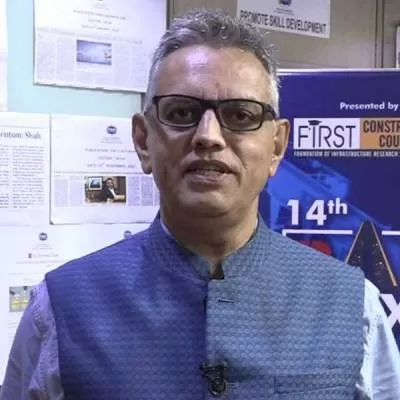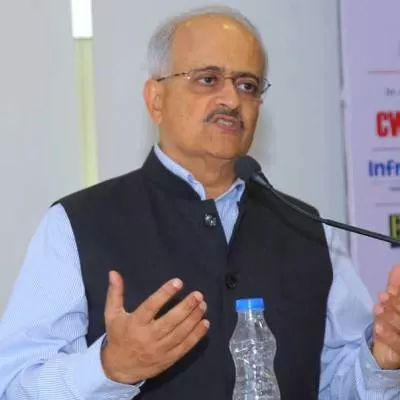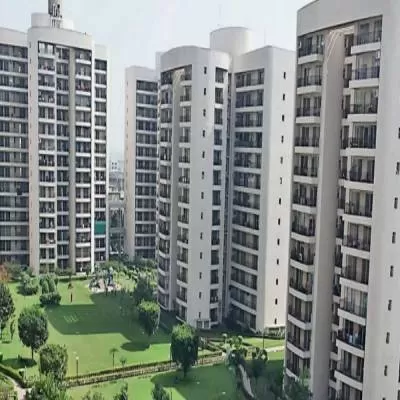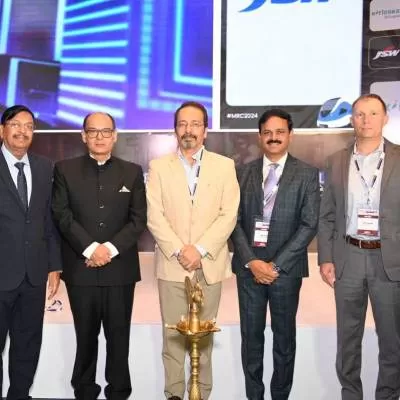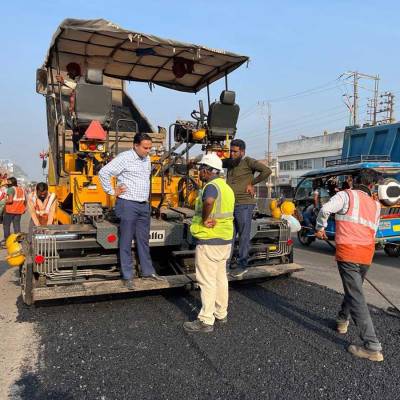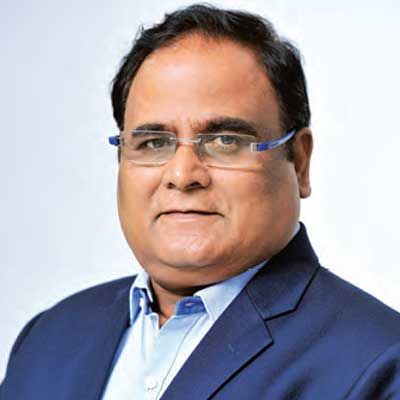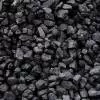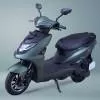- Home
- Real Estate
- Flowing on
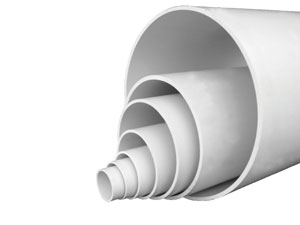
Flowing on
A sea change is taking place in the market for water distribution and sewerage pipes. Greater awareness about a host of new technologies on offer is increasing takers for alternative piping systems to traditional metallic pipes.
According to BSA Narayan, Principal Consultant, Maple Service Consultants, and Vice President, Indian Plumbing Association, "Galvanised steel pipes, the conventional material used for water supply systems, has given way to several non-metallic pipes such as polyvinyl chloride (PVC) pipes, chlorinated polyvinyl chloride (CPVC) pipes, polypropylene (PP) pipes, polyethylene (PE) pipes, PEX pipes, HDPE pipes, and polypropylene random copolymer (PPRC) pipes. Each material is suited for a certain type of application."
Variety market
Bharat City, a township offering affordable housing, makes use of polypropylene random pipes for water distribution "because they are fungus free, corrosion free, durable, eco-friendly and temperature resistant," explains Kumar Bharat, Director, BCC Infrastructures, Bharat City. Also, he has opted for PVC pipes for internal drainage "because these are low maintenance, lightweight and, therefore, easy and quick to install, with self-extinguishing properties that eliminate the need for fire-resistant coatings and are amenable to maintaining the pressure of water."
"Shubhkamna Tech Homes has adopted centrifugal pipes for sanitary purposes for being compact and lightweight, and for being available in standard sizes and amenable to further machining," shares Piyush Pushpak, Group Vice President, Shubhkamna Advert Group. "Chlorinated poly propylene chloride pipes are used for water supply." And S Suresh, General Manager, Best Pumps (India), expects takers for CPVC pipes and fittings that can withstand hot water (high temperatures) to grow as solar water heaters become more popular.
Nevertheless, traditionally high-end pipes such as copper and steel pipes and fittings remain the preferred choice for niche applications in hospitality, food industry, microbiology laboratories, research centres and hospitals.
Alternatives score
A sharp rise in the price of conventional metallic pipes and their vulnerability to corrosion are fuelling demand for alternative piping systems. Although plumbing and sanitation piping is only a minimal component of overall project costs, its importance stems from the potential of leakages and health issue in a building. These, coupled with rising metal prices, have forced real-estate developers to open up to alternative materials, especially polymers.
Arvind Joshi, Assistant Vice President, Finolex Industries Ltd, observes, "The Finolex plumbing and sanitation system is known to possess all the qualities sought in pipes." It is durable, lightweight, chemical resistant, weather resistant, UV-rays resistant, non-inflammable, non-conductive, non-corrosive and aesthetically superior to conventional metallic pipes. Being the country's largest manufacturer of PVC pipes and fittings with a pan-India reach helps Finolex ensure material availability off the shelf, which is of prime importance for buyers. "Being a major user of PVC, Finolex Industries Ltd has set up a backward integration plant for the manufacture of PVC resin," he adds. "Its PVC complex includes an open-sea cryogenic jetty, the first of its kind in the private sector in India. This ensures that Finolex is self-dependent for raw material supplies and has complete control on every quality parameter, from raw material to finished product."
Pumping volumes
As a revolutionary change is happening in the market for pumping solutions. Markets are flooded with makes and models to cater to the growing demand for pumps for different applications such as domestic water, wastewater and storm water. The mood is buoyant because of the pumping segment's inherent potential. According to Vikas Agarwal, General Manager & Business Head, Building & Construction Sector, Kirloskar Brothers Ltd, India, "Growth is slower than what it was three years ago but the market still has the potential to grow between 10 per cent and 15 per cent. Demand is more in the residential and institutional segments. But the fire, water supply, sewage and dewatering markets have good potential. Recently, the HVAC market has been growing as well."
Shifting trends
Watchful of salient trends in demand for pumps, front-running companies are adjusting their offerings to include total solutions. "As end customers become increasingly concerned about the total lifecycle cost of products, they are evaluating vendors for the potential to offer complete solutions from supply to service," shares Agarwal. "We are offering a wide variety of complete solution to customers from 1 hp to 1,000 hp pumps and package systems."
Another prominent trend is the emergence of higher capacity water booster pumps boasting of better technology to cater to the water pressure and distribution challenges faced by apartments in high-rise buildings. "Vertical multistage pumps are finding greater takers vis-a-vis horizontal pumps," states Narayan. "The former can serve as effective pressure boosting systems in the absence of overhead tanks."
According to Suresh, "Multi-stage booster pumps along with pressure tanks for individual flats have become the norm in high-rise buildings."
Interestingly, the growing adoption of high-end plumbing fittings is compounding the water pressure challenge and growing demand for booster pumps. "But shower panel fittings delivering multiple jets of water need booster pumps to function optimally," he explains.
New developments
An expanding market is encouraging many MNCs to enter the Indian market for pumps and bring new advanced technologies for various applications.
For their part, leading players are developing products that help realtors to derive more value from their projects. Space-saving products are one focus area for Kirloskar, driven by the recognition that space is money for real-estate developers. "Our new designed vertical, multi-stage, multi-outlet fire pumps for high-rise and super high-rise buildings can give builders more than two car park spaces extra," shares Agarwal. As important, Kirloskar is offering pumps boasting of green water and energy-saving features. "Our line-up of lowest lifecycle cost (LLC) pumps offers sustained efficiency levels over a longer period of time and a lower lifecycle cost vis-a-vis conventional pumps," he adds. "Kirloskar pumps are our choice for Bharat City, for their lower electricity consumption and efficient after-sales services, both of which are major plus points for residents. The pumps are effective and boast of a compact design," endorses Bharat.
Another interesting development is the emergence of solar-powered water pumps. Suresh sees demand for these growing in coming years as power shortages intensify.
Fitting times
Increasing urbanisation and growing middle class are helping to brighten the prospects of the plumbing fittings market. According to Atul Sanghvi, COO, CERA Sanitaryware Ltd, "The segment is growing at an estimated 15-16 per cent per annum."
Real-estate development is driving every segment of the plumbing fittings marketûlow-priced, mid-segment and high-end. As an example, æPeople First' is the slogan of Bharat City, a township offering affordable housing. So the project makes use of mid-priced fixtures that would make the lives of residents easier without compromising on aesthetics. "This includes Parryware stain-free and easy-to-clean fittings and stainless steel fittings that are relatively dust, maintenance and odour free," shares Bharat.
Shubhkamna tecHomes is focusing on achieving quality outcomes and cutting extra costs. To this end, it has opted for Commercial Plumbing (CP) brass fittings for the distribution of hot water in households. These are available in various sizes and boast of superior quality, high-strength and rust-resistant and corrosion-resistant properties. "Cost benefits kick in because brass fittings are more malleable than steel or iron ones," adds Pushpak. "This makes them amenable to speedy and easy fit-outs, which in turn can lower installation costs."
Intensifying competition
A bright forecast for fittings is attracting more companies to enter the fray. "India is a growing market where we want to achieve a leading position amongst the international brands. We are targeting the premium residential segment and premium hospitality projects," says Ravi Nindwani, Managing Director, Delta Faucet Company India, a new overseas entrant. In what is becoming an intensely competitive market, Indian brands such as Hindware, Cera and Parryware are competing against leading global players such as Grohe, Kohler, Delta Faucet and others. Intent on cornering a bigger share of the pie and proving their mettle to customers who are increasingly discerning and design aware, domestic brands are conducting serious R&D to come up with newer designs and products for the fast-growing market. For instance, Cera entered the faucet segment barely three years ago with a clear mandate, "To bring out products combining aesthetics with improved functionality and to continuously innovate to move up the value chain," explains Sanghvi. The very latest technology drives its faucet manufacturing plant to ensure that Cera collections boast of an impeccable mirror-like finish. Cera is committed to launching one new faucet design every quarter. Its recently launched Crayon series of quarter-turn faucet fittings has been very well accepted by the market.
Overseas brands with an eye to expand their India operations are establishing and expanding their manufacturing base or retail network in the country. "In coming months, we will create our point of sales for consumers and set up our retail footprint across the cities of India," shares Nindwani.
Evolving demand
Increasing urbanisation is evolving consumer preferences for faucets and showering fittings. Instead of being seen as basic functional hardware, these are being perceived as forms of self-expression and deliverers of experiences. As behavioural patterns undergo further change, Nindwani expects interactive faucets to gain in popularity. In this category, Delta offers faucets with Touch2O technology that turns faucets on and off with just a touch. "Water-conserving faucets and showering fittings will also find more takers," he predicts. This is why Delta is offering its H2Okinetic technology showerheads, each of which contains an internal system that sculpts the water jet into a unique wave pattern, creating a consumer-proven feeling of more water without using more water. "Last, Indian price and quality conscious consumers will prefer stylish but functional and durable products that can withstand the special water conditions in India," he adds. Delta valves with Diamond Seal technology grind debris and help the faucet last up to 5 million uses.
Also, green plumbing technology is bringing in a lot of water conserving products into the market, which are rated as water-efficient based on their adherence to local codes and standards. Increasing water scarcity and the green building movement are growing demand for such fittings. Narayan sees major change getting underway as fixtures are fine-tuned to fall under green norms set by regulatory authority or certifying agencies.
Clearly, maturing markets demand more utility and this is creating opportunities for players to evolve their product lines and grow volumes.
India-specific plumbing codesAccording to BSA Narayan, Vice-President and Convener of Technical Committee, Indian Plumbing Association (IPA), a set of India-specific user-friendly plumbing codes has been developed by IPA jointly with IAPMO Plumbing Codes and Standards Pvt Ltd. With this set of codes in place, plumbing professionals and the plumbing industry will get greater exposure to new standards on a par with international codes and standards. Here's the list of codes and standards jointly developed by IPA and IAPMO:
- Uniform Plumbing Code India 2011
- Uniform Plumbing Code India 2011: (Illustrated Training Manual)
- Green Plumbing Code Supplement India 2010
- Uniform Swimming Pool Code India 2011
- Water Efficient Products India 2011
- Uniform Solar Energy Code India 2012
To share your views on the Pipes & Fittings industry, write in at feedback@ASAPPmedia.com
The plumbing pipes, pumps and fittings segments are enjoying the flow-on effect of burgeoning construction activity, discovers CHARU BAHRI. A sea change is taking place in the market for water distribution and sewerage pipes. Greater awareness about a host of new technologies on offer is increasing takers for alternative piping systems to traditional metallic pipes. According to BSA Narayan, Principal Consultant, Maple Service Consultants, and Vice President, Indian Plumbing Association, "Galvanised steel pipes, the conventional material used for water supply systems, has given way to several non-metallic pipes such as polyvinyl chloride (PVC) pipes, chlorinated polyvinyl chloride (CPVC) pipes, polypropylene (PP) pipes, polyethylene (PE) pipes, PEX pipes, HDPE pipes, and polypropylene random copolymer (PPRC) pipes. Each material is suited for a certain type of application." Variety market Bharat City, a township offering affordable housing, makes use of polypropylene random pipes for water distribution "because they are fungus free, corrosion free, durable, eco-friendly and temperature resistant," explains Kumar Bharat, Director, BCC Infrastructures, Bharat City. Also, he has opted for PVC pipes for internal drainage "because these are low maintenance, lightweight and, therefore, easy and quick to install, with self-extinguishing properties that eliminate the need for fire-resistant coatings and are amenable to maintaining the pressure of water." "Shubhkamna Tech Homes has adopted centrifugal pipes for sanitary purposes for being compact and lightweight, and for being available in standard sizes and amenable to further machining," shares Piyush Pushpak, Group Vice President, Shubhkamna Advert Group. "Chlorinated poly propylene chloride pipes are used for water supply." And S Suresh, General Manager, Best Pumps (India), expects takers for CPVC pipes and fittings that can withstand hot water (high temperatures) to grow as solar water heaters become more popular. Nevertheless, traditionally high-end pipes such as copper and steel pipes and fittings remain the preferred choice for niche applications in hospitality, food industry, microbiology laboratories, research centres and hospitals. Alternatives score A sharp rise in the price of conventional metallic pipes and their vulnerability to corrosion are fuelling demand for alternative piping systems. Although plumbing and sanitation piping is only a minimal component of overall project costs, its importance stems from the potential of leakages and health issue in a building. These, coupled with rising metal prices, have forced real-estate developers to open up to alternative materials, especially polymers. Arvind Joshi, Assistant Vice President, Finolex Industries Ltd, observes, "The Finolex plumbing and sanitation system is known to possess all the qualities sought in pipes." It is durable, lightweight, chemical resistant, weather resistant, UV-rays resistant, non-inflammable, non-conductive, non-corrosive and aesthetically superior to conventional metallic pipes. Being the country's largest manufacturer of PVC pipes and fittings with a pan-India reach helps Finolex ensure material availability off the shelf, which is of prime importance for buyers. "Being a major user of PVC, Finolex Industries Ltd has set up a backward integration plant for the manufacture of PVC resin," he adds. "Its PVC complex includes an open-sea cryogenic jetty, the first of its kind in the private sector in India. This ensures that Finolex is self-dependent for raw material supplies and has complete control on every quality parameter, from raw material to finished product." Pumping volumes As a revolutionary change is happening in the market for pumping solutions. Markets are flooded with makes and models to cater to the growing demand for pumps for different applications such as domestic water, wastewater and storm water. The mood is buoyant because of the pumping segment's inherent potential. According to Vikas Agarwal, General Manager & Business Head, Building & Construction Sector, Kirloskar Brothers Ltd, India, "Growth is slower than what it was three years ago but the market still has the potential to grow between 10 per cent and 15 per cent. Demand is more in the residential and institutional segments. But the fire, water supply, sewage and dewatering markets have good potential. Recently, the HVAC market has been growing as well." Shifting trends Watchful of salient trends in demand for pumps, front-running companies are adjusting their offerings to include total solutions. "As end customers become increasingly concerned about the total lifecycle cost of products, they are evaluating vendors for the potential to offer complete solutions from supply to service," shares Agarwal. "We are offering a wide variety of complete solution to customers from 1 hp to 1,000 hp pumps and package systems." Another prominent trend is the emergence of higher capacity water booster pumps boasting of better technology to cater to the water pressure and distribution challenges faced by apartments in high-rise buildings. "Vertical multistage pumps are finding greater takers vis-a-vis horizontal pumps," states Narayan. "The former can serve as effective pressure boosting systems in the absence of overhead tanks." According to Suresh, "Multi-stage booster pumps along with pressure tanks for individual flats have become the norm in high-rise buildings." Interestingly, the growing adoption of high-end plumbing fittings is compounding the water pressure challenge and growing demand for booster pumps. "But shower panel fittings delivering multiple jets of water need booster pumps to function optimally," he explains. New developments An expanding market is encouraging many MNCs to enter the Indian market for pumps and bring new advanced technologies for various applications. For their part, leading players are developing products that help realtors to derive more value from their projects. Space-saving products are one focus area for Kirloskar, driven by the recognition that space is money for real-estate developers. "Our new designed vertical, multi-stage, multi-outlet fire pumps for high-rise and super high-rise buildings can give builders more than two car park spaces extra," shares Agarwal. As important, Kirloskar is offering pumps boasting of green water and energy-saving features. "Our line-up of lowest lifecycle cost (LLC) pumps offers sustained efficiency levels over a longer period of time and a lower lifecycle cost vis-a-vis conventional pumps," he adds. "Kirloskar pumps are our choice for Bharat City, for their lower electricity consumption and efficient after-sales services, both of which are major plus points for residents. The pumps are effective and boast of a compact design," endorses Bharat. Another interesting development is the emergence of solar-powered water pumps. Suresh sees demand for these growing in coming years as power shortages intensify. Fitting times Increasing urbanisation and growing middle class are helping to brighten the prospects of the plumbing fittings market. According to Atul Sanghvi, COO, CERA Sanitaryware Ltd, "The segment is growing at an estimated 15-16 per cent per annum." Real-estate development is driving every segment of the plumbing fittings marketûlow-priced, mid-segment and high-end. As an example, æPeople First' is the slogan of Bharat City, a township offering affordable housing. So the project makes use of mid-priced fixtures that would make the lives of residents easier without compromising on aesthetics. "This includes Parryware stain-free and easy-to-clean fittings and stainless steel fittings that are relatively dust, maintenance and odour free," shares Bharat. Shubhkamna tecHomes is focusing on achieving quality outcomes and cutting extra costs. To this end, it has opted for Commercial Plumbing (CP) brass fittings for the distribution of hot water in households. These are available in various sizes and boast of superior quality, high-strength and rust-resistant and corrosion-resistant properties. "Cost benefits kick in because brass fittings are more malleable than steel or iron ones," adds Pushpak. "This makes them amenable to speedy and easy fit-outs, which in turn can lower installation costs." Intensifying competition A bright forecast for fittings is attracting more companies to enter the fray. "India is a growing market where we want to achieve a leading position amongst the international brands. We are targeting the premium residential segment and premium hospitality projects," says Ravi Nindwani, Managing Director, Delta Faucet Company India, a new overseas entrant. In what is becoming an intensely competitive market, Indian brands such as Hindware, Cera and Parryware are competing against leading global players such as Grohe, Kohler, Delta Faucet and others. Intent on cornering a bigger share of the pie and proving their mettle to customers who are increasingly discerning and design aware, domestic brands are conducting serious R&D to come up with newer designs and products for the fast-growing market. For instance, Cera entered the faucet segment barely three years ago with a clear mandate, "To bring out products combining aesthetics with improved functionality and to continuously innovate to move up the value chain," explains Sanghvi. The very latest technology drives its faucet manufacturing plant to ensure that Cera collections boast of an impeccable mirror-like finish. Cera is committed to launching one new faucet design every quarter. Its recently launched Crayon series of quarter-turn faucet fittings has been very well accepted by the market. Overseas brands with an eye to expand their India operations are establishing and expanding their manufacturing base or retail network in the country. "In coming months, we will create our point of sales for consumers and set up our retail footprint across the cities of India," shares Nindwani. Evolving demand Increasing urbanisation is evolving consumer preferences for faucets and showering fittings. Instead of being seen as basic functional hardware, these are being perceived as forms of self-expression and deliverers of experiences. As behavioural patterns undergo further change, Nindwani expects interactive faucets to gain in popularity. In this category, Delta offers faucets with Touch2O technology that turns faucets on and off with just a touch. "Water-conserving faucets and showering fittings will also find more takers," he predicts. This is why Delta is offering its H2Okinetic technology showerheads, each of which contains an internal system that sculpts the water jet into a unique wave pattern, creating a consumer-proven feeling of more water without using more water. "Last, Indian price and quality conscious consumers will prefer stylish but functional and durable products that can withstand the special water conditions in India," he adds. Delta valves with Diamond Seal technology grind debris and help the faucet last up to 5 million uses. Also, green plumbing technology is bringing in a lot of water conserving products into the market, which are rated as water-efficient based on their adherence to local codes and standards. Increasing water scarcity and the green building movement are growing demand for such fittings. Narayan sees major change getting underway as fixtures are fine-tuned to fall under green norms set by regulatory authority or certifying agencies. Clearly, maturing markets demand more utility and this is creating opportunities for players to evolve their product lines and grow volumes.India-specific plumbing codes According to BSA Narayan, Vice-President and Convener of Technical Committee, Indian Plumbing Association (IPA), a set of India-specific user-friendly plumbing codes has been developed by IPA jointly with IAPMO Plumbing Codes and Standards Pvt Ltd. With this set of codes in place, plumbing professionals and the plumbing industry will get greater exposure to new standards on a par with international codes and standards. Here's the list of codes and standards jointly developed by IPA and IAPMO: Uniform Plumbing Code India 2011 Uniform Plumbing Code India 2011: (Illustrated Training Manual) Green Plumbing Code Supplement India 2010 Uniform Swimming Pool Code India 2011 Water Efficient Products India 2011 Uniform Solar Energy Code India 2012 To share your views on the Pipes & Fittings industry, write in at feedback@ASAPPmedia.com



